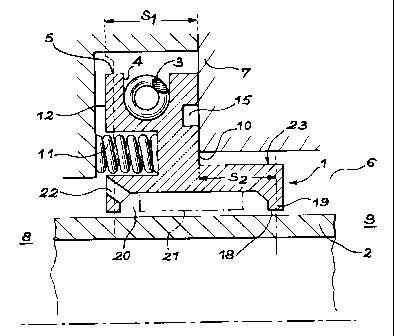Some of the information on this Web page has been provided by external sources. The Government of Canada is not responsible for the accuracy, reliability or currency of the information supplied by external sources. Users wishing to rely upon this information should consult directly with the source of the information. Content provided by external sources is not subject to official languages, privacy and accessibility requirements.
Any discrepancies in the text and image of the Claims and Abstract are due to differing posting times. Text of the Claims and Abstract are posted:
| (12) Patent: | (11) CA 2279558 |
|---|---|
| (54) English Title: | SEALING ARRANGEMENT WITH AUTOMATIC CLEARANCE ADJUSTMENT |
| (54) French Title: | DISPOSITIF ETANCHE AYANT UN SYSTEME DE REGLAGE D'ECARTEMENT AUTOMATIQUE |
| Status: | Term Expired - Post Grant Beyond Limit |
| (51) International Patent Classification (IPC): |
|
|---|---|
| (72) Inventors : |
|
| (73) Owners : |
|
| (71) Applicants : |
|
| (74) Agent: | LAVERY, DE BILLY, LLP |
| (74) Associate agent: | |
| (45) Issued: | 2008-12-09 |
| (22) Filed Date: | 1999-08-03 |
| (41) Open to Public Inspection: | 2000-02-05 |
| Examination requested: | 2004-05-19 |
| Availability of licence: | N/A |
| Dedicated to the Public: | N/A |
| (25) Language of filing: | English |
| Patent Cooperation Treaty (PCT): | No |
|---|
| (30) Application Priority Data: | ||||||
|---|---|---|---|---|---|---|
|
The seal is composed of butt-jointed segments (1) in which the bearing surface (18) on a rotating part (2) subject to wear, includes a hollow chamber (20) communicating through calibrated orifices (22) with a high pressure containment (8). Therefore, it fills up with gas which tends to force it away from the surface, thus reducing the contact pressure without introducing excessive leaks. Figure 2.
Le joint est composé de segments (1) mis bout à bout, dans lesquels la surface d'appui (18) sur une pièce rotative (2) sujette à l'usure comprend une chambre creuse (20) communiquant à travers des orifices calibrés (22) avec un confinement haute pression (8). Par conséquent, il se remplit de gaz qui tend à l'écarter de force de la surface, réduisant ainsi la pression de contact sans présenter de fuites excessives. Figure 2.
Note: Claims are shown in the official language in which they were submitted.
Note: Descriptions are shown in the official language in which they were submitted.

2024-08-01:As part of the Next Generation Patents (NGP) transition, the Canadian Patents Database (CPD) now contains a more detailed Event History, which replicates the Event Log of our new back-office solution.
Please note that "Inactive:" events refers to events no longer in use in our new back-office solution.
For a clearer understanding of the status of the application/patent presented on this page, the site Disclaimer , as well as the definitions for Patent , Event History , Maintenance Fee and Payment History should be consulted.
| Description | Date |
|---|---|
| Inactive: Expired (new Act pat) | 2019-08-03 |
| Revocation of Agent Request | 2018-09-14 |
| Appointment of Agent Request | 2018-09-14 |
| Inactive: Agents merged | 2018-09-01 |
| Appointment of Agent Request | 2018-08-30 |
| Inactive: Agents merged | 2018-08-30 |
| Revocation of Agent Request | 2018-08-30 |
| Grant by Issuance | 2008-12-09 |
| Inactive: Cover page published | 2008-12-08 |
| Pre-grant | 2008-09-23 |
| Inactive: Final fee received | 2008-09-23 |
| Notice of Allowance is Issued | 2008-06-02 |
| Letter Sent | 2008-06-02 |
| Notice of Allowance is Issued | 2008-06-02 |
| Inactive: Approved for allowance (AFA) | 2008-04-23 |
| Letter Sent | 2008-02-22 |
| Letter Sent | 2008-02-22 |
| Letter Sent | 2008-02-22 |
| Letter Sent | 2008-02-22 |
| Letter Sent | 2008-02-22 |
| Letter Sent | 2008-02-22 |
| Letter Sent | 2008-02-22 |
| Amendment Received - Voluntary Amendment | 2008-01-29 |
| Inactive: S.30(2) Rules - Examiner requisition | 2007-07-30 |
| Amendment Received - Voluntary Amendment | 2006-10-03 |
| Inactive: S.30(2) Rules - Examiner requisition | 2006-04-04 |
| Inactive: IPC from MCD | 2006-03-12 |
| Amendment Received - Voluntary Amendment | 2004-09-13 |
| Letter Sent | 2004-05-31 |
| All Requirements for Examination Determined Compliant | 2004-05-19 |
| Request for Examination Requirements Determined Compliant | 2004-05-19 |
| Request for Examination Received | 2004-05-19 |
| Letter Sent | 2003-11-13 |
| Letter Sent | 2003-11-13 |
| Application Published (Open to Public Inspection) | 2000-02-05 |
| Inactive: Cover page published | 2000-02-04 |
| Letter Sent | 1999-11-03 |
| Inactive: Single transfer | 1999-10-08 |
| Inactive: First IPC assigned | 1999-09-23 |
| Inactive: IPC assigned | 1999-09-23 |
| Inactive: Courtesy letter - Evidence | 1999-09-14 |
| Inactive: Filing certificate - No RFE (English) | 1999-09-08 |
| Application Received - Regular National | 1999-09-07 |
There is no abandonment history.
The last payment was received on 2008-07-24
Note : If the full payment has not been received on or before the date indicated, a further fee may be required which may be one of the following
Patent fees are adjusted on the 1st of January every year. The amounts above are the current amounts if received by December 31 of the current year.
Please refer to the CIPO
Patent Fees
web page to see all current fee amounts.
Note: Records showing the ownership history in alphabetical order.
| Current Owners on Record |
|---|
| SNECMA |
| Past Owners on Record |
|---|
| DANIEL OLIVIER BAINACHI |